RPG Codex Preview: Might & Magic X: Legacy, Now with Act II
RPG Codex Preview: Might & Magic X: Legacy, Now with Act II
Preview - posted by Crooked Bee on Fri 20 December 2013, 17:50:55
Tags: Limbic Entertainment; Might & Magic X - Legacy; UbisoftLimbic Entertainment's Might & Magic X: Legacy releases on Steam on January 23rd. Thanks to Limbic and Ubisoft, we got exclusive (tm) press access to Act II of the game. How good is this new act, and how does the game fare as a whole in its current state?
In this preview, Zeriel attempts to find out just that. To spice things up a bit, he's also accompanied by Broseph who adds a few scattered remarks here and there. Have a snippet:
Read the full article: RPG Codex Preview: Might & Magic X: Legacy, Now with Act II
In this preview, Zeriel attempts to find out just that. To spice things up a bit, he's also accompanied by Broseph who adds a few scattered remarks here and there. Have a snippet:
Act II brings with it the majority of the open world, and a handful of new dungeons, along with the town of Seahaven. 2 new classes are on offer over the current Early Access. The first is the Rune Priest, a dwarven spellcaster who can master Light and Fire, providing strong healing and damage dealing capabilities. The second class is the Marauder, the Orc take on the rogue archetype who focuses on Spears and Dodge, with a class promotion ability to lay traps later on.
Seahaven is the standout addition in the exclusive preview. While not the largest town in the game (Karthal presumedly takes on that role), it is considerably larger than Sorpigal, offering a variety of Expert and Master trainers, and several new quests to boot. Aesthetically it's also more impressive than Sorpigal, featuring a Naga and Dwarven quarter in addition to the usual human element.
[...] The open world is indisputably the star of MMXL. Once past the "tutorial area" that is Act I, the world awaits. There are no artificial restraints placed on your party. You can go wherever you want, whenever you want. Sure, you might die horribly, but that's a definite part of the charm. Some areas--such as islands or mountain ranges--require the Blessings to reach, but the Blessings themselves are merely a matter of exploration to obtain.
Trundling my party around the open world like a pack of ravenous hobos in search of crystal meth was by far the most fun I had with the exclusive preview. Beyond each twist in the road there's a new type of enemy, a crypt with a riddle to investigate, and a treasure chest hidden behind a stand of trees. This is MMXL at its best, and why you should absolutely keep an eye on it if you are a fan of the open-world blobber gameplay that Might & Magic and Wizardry pioneered.
It's hard to put into words what's so addictive about this very basic sort of appeal, especially since wandering Skyrim's frozen wastes isn't half as interesting. On paper, they should be virtually identical. Maybe it's something to do with how very quantized a grid-based game is. Every other tile of the world is there for a reason, has something to do. MMXL doesn't have huge tracts of wilderness filled with nothing simply because it would be realistic. In terms of 3D real estate, MMXL is much smaller than the AAA giants of the industry, but it feels big.
Broseph: I quite enjoyed the Rune Priest class in particular. It's a classic glass cannon archetype and does a very good job of both dishing out damage and shielding your allies from harm. I found having a Rune Priest in my party to be a big help with some of the nastier enemies in Act II.
Zeriel: The class balance is a little alarming. Even at this early stage there are clearly classes that are simply not as good at others at their chosen role. Why use a Marauder over a Ranger? The Ranger is better at dealing damage. The Marauder can block attacks very well, but if that's the role you're after, there are defensive melee classes that are better at it. In a way, though, this is very old school. In Baldur's Gate 2, the correct choice of class was always sorceror, no matter what. In earlier Might & Magic games, there was almost always a class that was the best at any given job, and then the mediocre ones.
Zeriel: The class balance is a little alarming. Even at this early stage there are clearly classes that are simply not as good at others at their chosen role. Why use a Marauder over a Ranger? The Ranger is better at dealing damage. The Marauder can block attacks very well, but if that's the role you're after, there are defensive melee classes that are better at it. In a way, though, this is very old school. In Baldur's Gate 2, the correct choice of class was always sorceror, no matter what. In earlier Might & Magic games, there was almost always a class that was the best at any given job, and then the mediocre ones.
Seahaven is the standout addition in the exclusive preview. While not the largest town in the game (Karthal presumedly takes on that role), it is considerably larger than Sorpigal, offering a variety of Expert and Master trainers, and several new quests to boot. Aesthetically it's also more impressive than Sorpigal, featuring a Naga and Dwarven quarter in addition to the usual human element.
[...] The open world is indisputably the star of MMXL. Once past the "tutorial area" that is Act I, the world awaits. There are no artificial restraints placed on your party. You can go wherever you want, whenever you want. Sure, you might die horribly, but that's a definite part of the charm. Some areas--such as islands or mountain ranges--require the Blessings to reach, but the Blessings themselves are merely a matter of exploration to obtain.
Trundling my party around the open world like a pack of ravenous hobos in search of crystal meth was by far the most fun I had with the exclusive preview. Beyond each twist in the road there's a new type of enemy, a crypt with a riddle to investigate, and a treasure chest hidden behind a stand of trees. This is MMXL at its best, and why you should absolutely keep an eye on it if you are a fan of the open-world blobber gameplay that Might & Magic and Wizardry pioneered.
It's hard to put into words what's so addictive about this very basic sort of appeal, especially since wandering Skyrim's frozen wastes isn't half as interesting. On paper, they should be virtually identical. Maybe it's something to do with how very quantized a grid-based game is. Every other tile of the world is there for a reason, has something to do. MMXL doesn't have huge tracts of wilderness filled with nothing simply because it would be realistic. In terms of 3D real estate, MMXL is much smaller than the AAA giants of the industry, but it feels big.
Broseph: The wilderness areas in this game are downright awesome. Incredibly fun to explore, with lots of well-hidden secrets and goodies. The map design positively reminds me of MM3. Exploring the overworld here doesn't feel like a chore at all, unlike in some other games of this type where the dungeons are the real meat and potatoes of the experience.
Read the full article: RPG Codex Preview: Might & Magic X: Legacy, Now with Act II
[Written by Zeriel, with additional comments by Broseph]
Limbic Entertainment's Might & Magic X: Legacy releases on Steam on January 23rd. Thanks to Limbic and Ubisoft, we got exclusive (tm) press access to Act II of the game. How good is this new act, and how does the game fare as a whole in its current state?
In this preview, Zeriel attempts to find out just that. To spice things up a bit, he's also accompanied by Broseph who adds a few scattered remarks here and there.

Hands-On-Collar Preview
It seems like only yesterday that we penned acondemnation of all things Ubisoft rather positive preview of Might & Magic X: Legacy. Actually, it's been several months. We've failed to meet our own high standards of journalistic integrity, and today we're here to fix that glaring wrong. As you may or may not remember, Limbic and Ubisoft have been running a lovely little thing called Early Access where people can pre-order the game and then receive a development build, previewing the game as its built. Several patches introduced a plethora of bugfixes and new classes, while never really broadening the content available or offering new zones to visit. That ends today.
Ubisoft was kind enough to send us an exclusive preview build with a large portion of Act II available, huge swathes of the open world, along with 2 more classes to try out. And for the furry enthusiasts, we've even got a bare-chested minotaur.
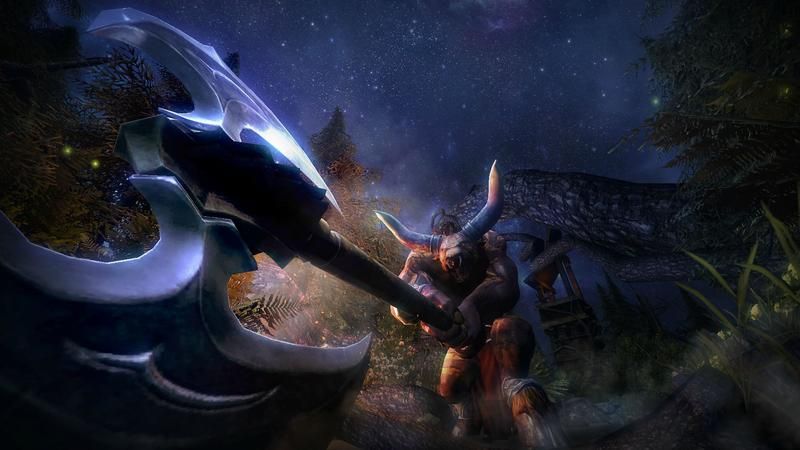
You're welcome, Jasede.
Might & Magic X: So This Is That Grimrock Clone, Right?
Over a decade ago, the executives of 3DO were in a closed doors meeting discussing the future of a wildly popular RPG and Strategy franchise. "So, we've got this great brand. It has successful titles in two genres, and dedicated fans. How can we take this to the next level? Any ideas? Allen?"
"I know," said Allen, who unbeknownst to his fellow executives was the devil incarnate. "Why don't we push out a title in a year of development time, and switch to a completely unproven new engine? I hear Lithtech's all the rage with the kids!"
A year later, Might and Magic 9 came out, failed miserably, and a storied franchise died a horrible death. Through the incestuous horror that is copyright law, it somehow ended up in the claws of Ubisoft who... decided to revive it as a turn-based blobber? When MMXL was first announced, many at the Codex could not reconcile these two opposing concepts: Ubisoft of Assassin's Creed and Far Cry was reviving Might & Magic as a turn-based RPG? A turn-based RPG with grid movement?
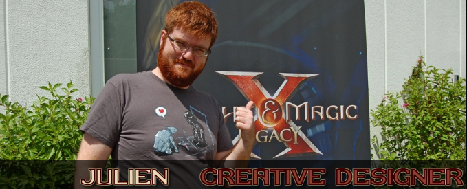
Julien Pirou, Creative Designer on MMXL, moments before casting a hex of mind control.
Eventually the dark secret of MMXL's genesis leaked out: a clever warlock by the name of Julien Pirou had infiltrated the highest ranks of Ubisoft and used his witchcraft to subvert its executives to his will. Either that, or Ubisoft decided a niche title was a smart investment in a swamped AAA market where fighting for market share was increasingly futile. I ask you, which scenario is more plausible?
Partnered with Limbic, Ubisoft looked back to the earlier titles in the franchise for inspiration, while inviting a small group of VIP fans to discuss the development of the new product. Specifically, Might and Magic V: Darkside of Xeen, the last game in the series to feature fully turn-based combat and movement set in a grid.
If you're an old grognard who grew up playing games like Wizardry and the earliest Might and Magic titles, you don't need to know anything more: Might & Magic X is a beautiful dinosaur that just stepped out of a time machine. It marries old-fashioned mechanics that should never have been abandoned with a modern graphical approach. There is nothing else on the market quite like it, and for the fans of this forgotten genre it's an unavoidable day one purchase.
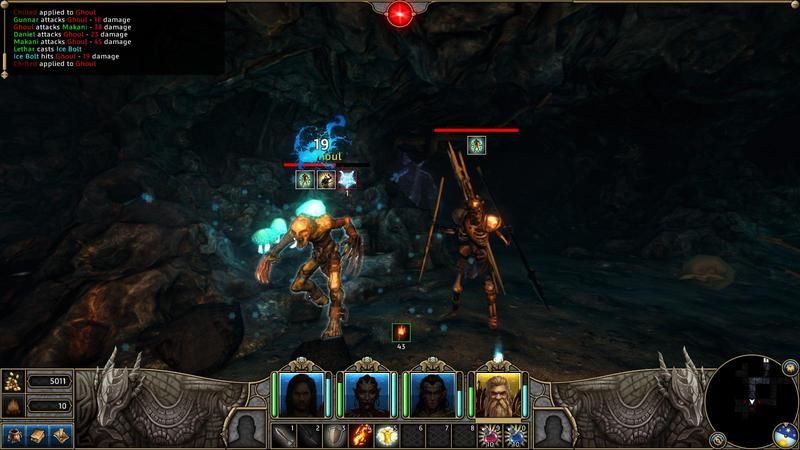
Be still, my heart! It's turn-based combat. In my 2013?
Welcome to Ashan
From a story perspective, MMXL has no connection to the previous Might & Magic games. It takes place on Ashan, a new high-fantasy setting used by the Heroes series that is Ubisoft's take on the franchise. It's the sort of place where Dragons are Gods instead of living loot factories, demons and angels are only living embodiments of evil and good rather than aliens jetting around in spaceships, and so on and so forth. Julien Pirou being the conniving warlock that he is, however, there are little references dotted throughout the game to the previous universes of Might and Magic. They vary from the sublime (subtle references that only leap out if you've played through the series) to the ridiculous (books of poetic verse written by 'Lord Caneghem' that detail the exploits of earlier games).
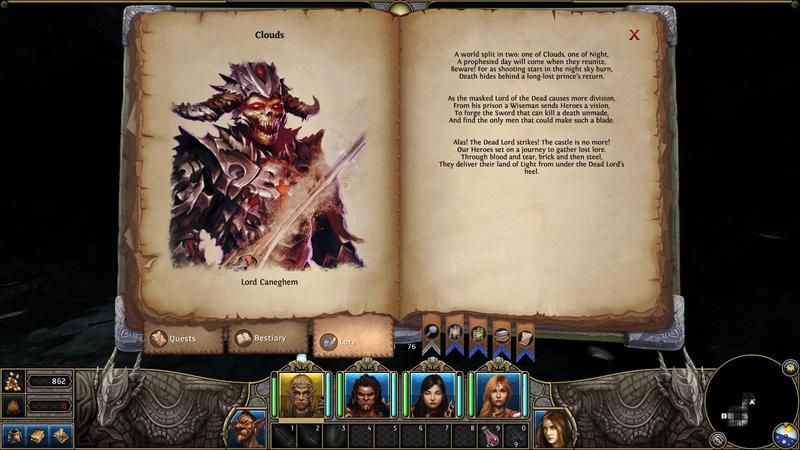
Real subtle, guys.
I'm of two minds on these easter eggs: on the one hand, it would be nice if fan input and Pirou's vile warlock incantations could one day convince Ubisoft to make a Might & Magic sequel with sci-fi elements. If, on the other hand, that's never going to happen, I wish they'd stop rubbing our face in that impossibility, and have more faith in their high fantasy setting. Within the scope of MMXL, Ashan is at times charming, and certainly always more believable than it ever was in Heroes 6. I'd like to think the fans of Might & Magic can come to enjoy Ashan without the sly references. The real reason we're playing MMXL, after all, is that it lives up to the gameplay legacy of Might & Magic, not because we're pining away for the Temple of Baa.
The Life of the Party
Party creation is bog standard for the genre... two decades ago, in any case. You have the option of using a pregenerated party with a balanced class makeup, generating a completely random party (what genius came up with this idea?), or manual creation. Manual creation feels like the whole point of the game, but it's nice that Limbic gave some other options for those who bought, downloaded, and played MMXL on the mistaken assumption they were actually clicking the Skyrim icon on their desktop.
MMXL offers the option of two separate difficulty levels: Adventurer, and Warrior. It's hard to say which represents the "baseline" experience. As a longtime fan of the series, I found that I was only getting the challenge I wanted on Warrior, but Adventurer is no push-over for someone completely new to the genre. The changes between the difficulties are exclusively number-oriented: costs for everything from training skill tiers to buying equipment to fetching camping supplies are drastically increased on Warrior, and monster health and damage is also bumped up. There are no rewards or incentives, so it's purely a lifestyle choice.
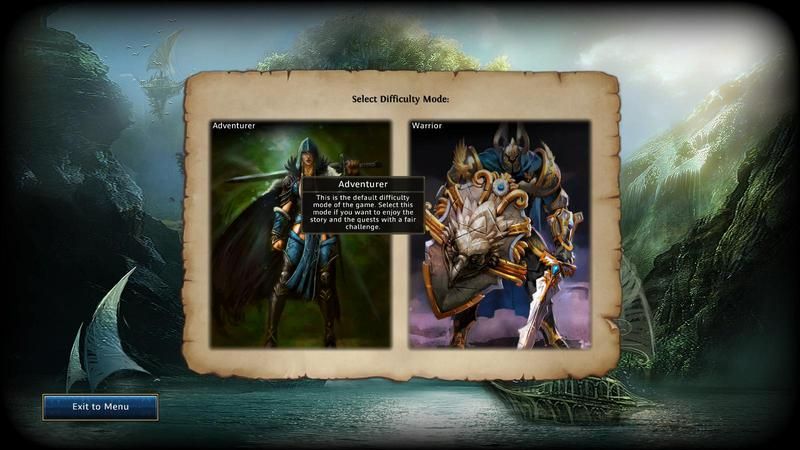
Go right ahead. Just know that I'm judging you. From on high.
Character creation starts with choosing a race, which in turn determines the classes available to you. Every race has 3 classes, one each of the three archetypes: fighter, rogue, caster. Depending on the race, the flavor of these classes differs drastically. The elven rogue class, the Ranger, can max out the Dagger skill completely, becoming a fragile but deadly damage-dealing machine. Meanwhile, the Orc rogue archetype is the Marauder, a trap-laying barbarian who specializes in spears and avoids getting hit in the first place.
Classes in MMXL are basically just packages of skills: some classes can't pick certain skills, or are the only class able to raise that skill to the highest tier of mastery. Every class also has a promotion quest that transforms them into a paragon of their class with a new, added ability. As an example, the Freemage promotion gives the ability to stop time in an area around the party. Veterans of the series will find the cockles of their heart warmed by the inclusion of familiar skills, but a few are alarming in their absence. Alchemy, Diplomacy, Repair Item, Merchant... you're probably noticing a theme. All the trimmed skills are non-combat in nature. Thankfully, they're not simply gone. Many hirelings found in the world approximate the effects of the missing skills, like a follower who will improve your dealings with shops drastically, or one who repairs items for you at any time.
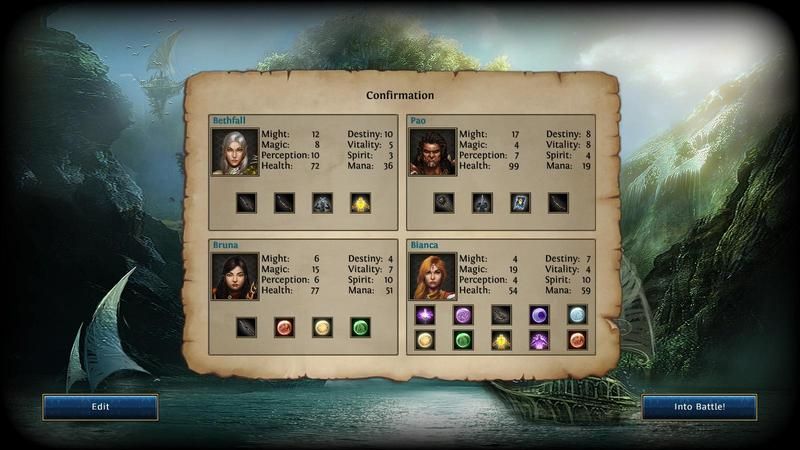
Only one Pao Deathseeker. Must be a new player.
Meanwhile, the terrain traversal skills of Xeen are encapsulated in the concept of Blessings: favors from the Dragon Gods (they're for praying to, not stabbing in the gut) that eventually allow your party to walk on water, climb mountains, sneak between forest hedges, and so forth.
Ultimately though, MMXL is a game about combat, for people who love combat. All its skills and systems tend to revolve around combat, and even character creation ends with a button that says 'Into Battle'. In this way, it's little different from its predecessors, which were always about exploring strange places, butchering whoever lived there, and then taking their stuff.
While We're Here...
MMXL begins with your party unceremoniously shoved onto the dock of a small village, a sunny place named Sorpigal. A very brief narration establishes the story thus far: you are raiders, mercenaries in everything but name. Owen, your mentor, recently passed away, and his dying wish was that you take his ashes to the chapel in Karthal, the regional capitol of the Agyn Peninsula. Naturally you can't just head there directly, though! A series of coincidences and obstacles rise up on the way, and present the meat of the game. In a game about story, such a transparent ruse would be irritating, but with MMXL I just found myself smiling and going along with the developer's excuses meant to get me into the fray, slaying spiders and nagas and shadow dragons because... uh, you know, it's somehow terribly important to my quest. There's a well full of spiders? Sure, why not.
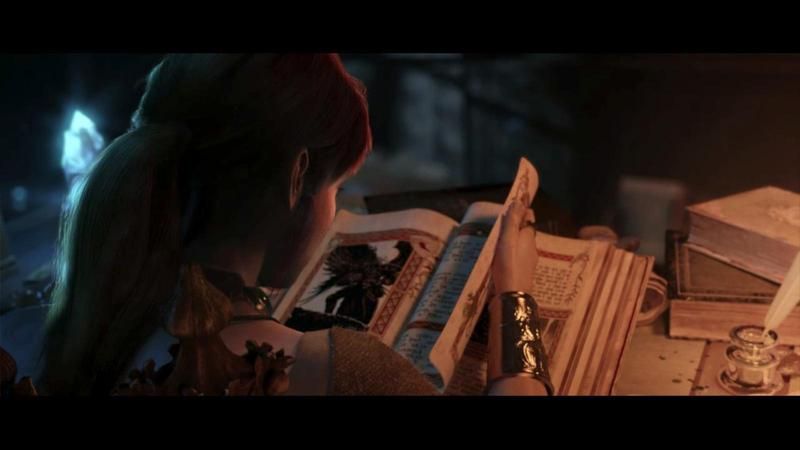
And so began the epic tale of how a group of homeless vagrants lawnmowered our entire world in search of things to sell.
While the setting is high fantasy, the plot of the game is very low-fantasy: you are in the Agyn Peninsula to fulfill a debt to a dead friend. As you get closer to Karthal, you discover the city is a hive of political intrigues tied to secession from the Empire. While there are villains and heroes, MMXL goes with a much more down to earth and pragmatic style than Heroes 6. Personally, I enjoyed it. If you thrive on being the Chosen One fated by Destiny to save the world, you might be a lot less satisfied.
Such Combat, Much Strategy
We've talked about combat in an oblique way before, but I wanted to dive into it in more detail especially because a lot of previews have glossed over this. What makes it good? What makes it bad?
Combat is turn-based. Your party goes through a round of actions, and then the enemy acts. You can only move during combat before any of your characters have acted, and if you choose to do so, your characters won't attack or cast spells that turn. In addition, once you're in melee range with an enemy, you can't back up. While at first blush these restrictions seem like emphatic negatives, in fact they are responsible for much of what is great about MMXL's combat.
Because you can't simply always backpedal and pepper your enemies with volleys of arrows and spells (a dominant tactic in M&M 6-8), terrain and obstacles become a serious consideration in combat. Luring enemy archers around a corner is much safer than trying to charge at them through a hail of covering fire. Some spells help with manipulating these basic elements: Gust of Wind, an air spell, will knock a target enemy back one square, allowing an all-ranged party to toy with melee combatants at their leisure.
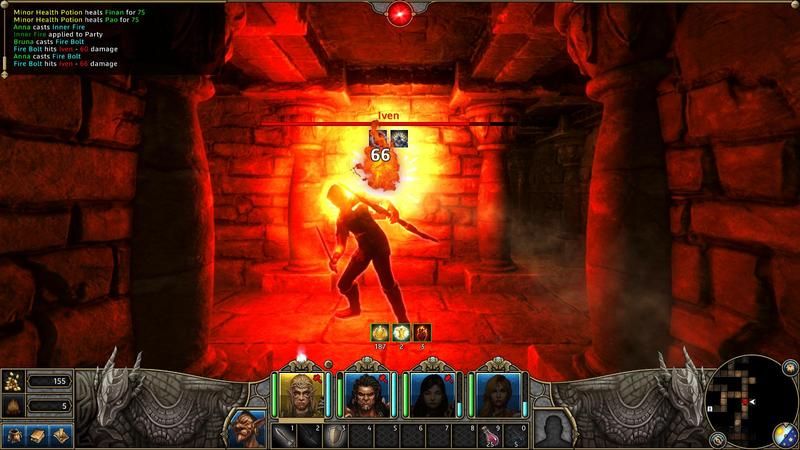
'Much Strategy' hereby defined as 'keep burning it until it's dead'.
Compared to earlier Might and Magic games, melee characters are much more interesting. Instead of autoattacking ad nauseam, they can specialize in the Warfare skill, which provides an entire line of melee "spells", with strikes that taunt an enemy into attacking that character, always hit and ignore blocks, or silence enemy spellcasters. As a result, beefy frontliner characters have a solid niche in MMXL.
Enemy design adds to the mix. In many areas, each new enemy you run into uses a completely different mechanic to challenge your typical approach to combat. Just when you feel like your Ranger with 4 attacks a round is turning into an overpowered death machine, a monster arrives that not only blocks the first few strikes in a round, but gets extra attacks on his round based on how many times he blocked or was missed on your round. An all melee party would be uniformly powerful... until it starts running into the monsters that stun and incapacitate when they attack, suddenly making that spellcaster with a stun immunity spell look quite useful.
Finally, the elephant in the room: monster animations suck. No, I don't mean aesthetically. The monster art is uniformly good, much of it ported over from the visually impressive Heroes 6. The animations are smooth. The problem is that the animations have no options attached to them. You cannot speed them up. You cannot toggle them to skip once you've seen them all a million times. This is further exacerbated by the way your own combat moves work: they all fire instantly, and the animations and special effects do not have to finish before your next character can act. The end result is a quick, ultra satisfying turn on your end, followed by watching the enemy plod through animations you've already seen before. If Limbic addresses this fundamental issue, they'll have one of the best turn-based combat games in recent memory. If they don't... well, it'll still be good, but with a sidedish of irritating, and probably not an enduring classic.
Right, But What's Changed?
Act II brings with it the majority of the open world, and a handful of new dungeons, along with the town of Seahaven. 2 new classes are on offer over the current Early Access. The first is the Rune Priest, a dwarven spellcaster who can master Light and Fire, providing strong healing and damage dealing capabilities. The second class is the Marauder, the Orc take on the rogue archetype who focuses on Spears and Dodge, with a class promotion ability to lay traps later on.
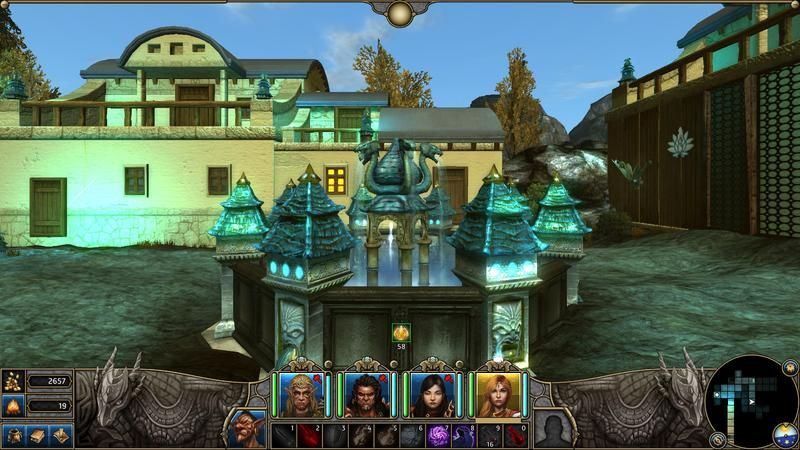
New Dojo, new rules.
Seahaven is the standout addition in the exclusive preview. While not the largest town in the game (Karthal presumedly takes on that role), it is considerably larger than Sorpigal, offering a variety of Expert and Master trainers, and several new quests to boot. Aesthetically it's also more impressive than Sorpigal, featuring a Naga and Dwarven quarter in addition to the usual human element.
The new dungeons include Sudgerd, a lost dwarven city hidden in the mountains that fell to some shadowy evil in centuries past. Tales of madness and ruin offer a nice preview of what's to come, and the promotion quest for the Rune Priest involves relighting the fires of Arkath (that's one of those Dragon Gods) in the center of Sudgerd. To do so, you'll have to fight... well... not to put too fine a point on this, but I think the Codex is amply equipped to deal with plumbing the "depths" of this "dungeon".

Ubisoft included this lovely little picture in the press packet. How well they know us.
The earliest builds of the early access (including the one our own Zed previewed) lacked things like stores restocking potions and changing their inventory every few days. That's been changed, along with a lot of general polish in terms of lighting and area design. In Act I especially, entire regions have had monsters moved around or replaced with something else--instead of fighting brigands and militiamen right outside the gates of Sorpigal, the player now encounters wildlife like wolves.
The change to stores doesn't really affect the difficulty. While you can always wait for more potions to restock in stores, it hardly trivializes the game. Especially on Warrior difficulty, the limiting factor at any time is gold, which can only be obtained by pushing forward into new areas, since monsters never respawn. You'll find yourself wanting to spend it on skill training and items much more often than potions. This creates an interesting dynamic in the early to midgame: the player can never sit back on his ass and farm until he feels overpowered and ready to face any challenge. The game always nudges you ahead into something that's just hard enough to keep your attention.
We were told that all of the content in the exclusive preview amounted to about 30% of the final game. This is interesting considering there will only be four acts--suggesting that the Act II we played was not the entirety of the Act II that will be in the retail product.
Deeply Delving Dungeons
What's a Might and Magic game without dungeons? At first blush, I was a little disappointed in this area. The very first dungeon in MMXL is a short, linear affair that calls to mind all the worrisome trends of the last decade. Things change quickly, however, and by the time Act I ends you're breaking into secret passages in search of treasure chests, flipping switches and backtracking to find unexplored rooms.
Fundamentally there's nothing mindblowing about what MMXL uses to break up the pace of monster genocide: levers to open passages that lead to keys to locked doors in another part of the dungeon, but the abundance of riddles and puzzles is definitely much needed in a game that relies so heavily on combat.
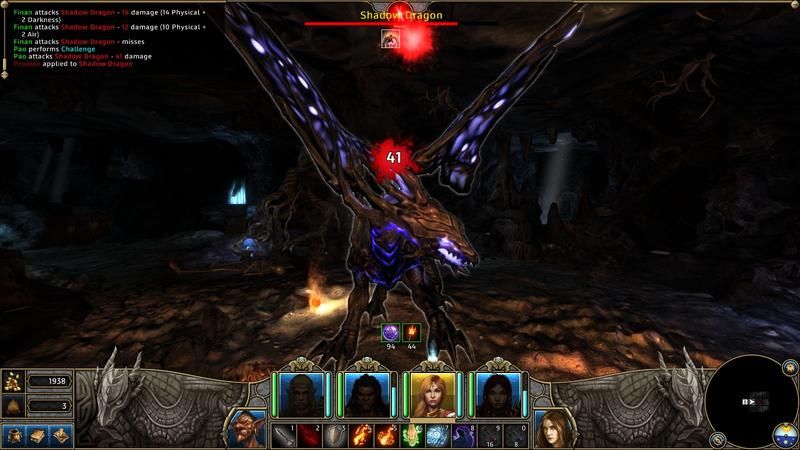
You may recall this dashing young fellow from the concept art.
MMXL reaches the bar set by the previous games in this department, but doesn't really venture any further. The average dungeon in MMXL is probably a little more complicated than the most standard ones in For Blood & Honor, say, but overall the design is just on par. What really impressed me with MMXL's dungeons was the pacing. They're just long enough to threaten to exhaust your supplies, maybe even merit a return to town and a second visit, but just about every time I was reaching that familiar mental stage of 'Shouldn't I be reaching the end about now?', a boss would pop up, and I'd be finishing off the dungeoncrawl. Such consistency isn't easy to nail, and it's nice to see competency from what is basically an untested developer when it comes to this genre.
You'll See, I'll Be King Of The World, One Day...
Character progression in MMXL feels dramatically quicker than in Might and Magic 6-8. Perhaps this is in part due to the shrinking of encounter size (the 3D, quasi-real-time era of Might & Magic had a propensity of throwing absurd numbers of enemies at you), but it's still worth mentioning. My hunch is that this is a game of horizontal rather than vertical depth: a large world to explore, but not one in which it will take very long to turn your party into a powerhouse. Within a few hours, yourhobos heroes will be obtaining Mastery in multiple skills and armwrestling with cyclops.
Weapons also play a much larger role in 'physical' characters' performance. It's not uncommon to get the next 'tier' of weapon and find your damage doubling. It was always the case that melee characters in Might & Magic derived much more benefit from weapons than spellcasters, but this trend is only accelerated in MMXL. Where a melee character's damage might double from a weapon upgrade, a spellcaster will get a staff that gives +3 to their chosen spellcasting skill, offering a benefit of maybe 15% increased damage. You may be noticing a small difference between "+100%" and "+15%". Spellcasters have their own immense benefits to recommend them to any party, like heaping spoonfuls of area of effect damage, and all sorts of utility that can't be had any other way. Does that merit allowing melee to scale with gear in such a superior way? At this stage, it's hard to say.
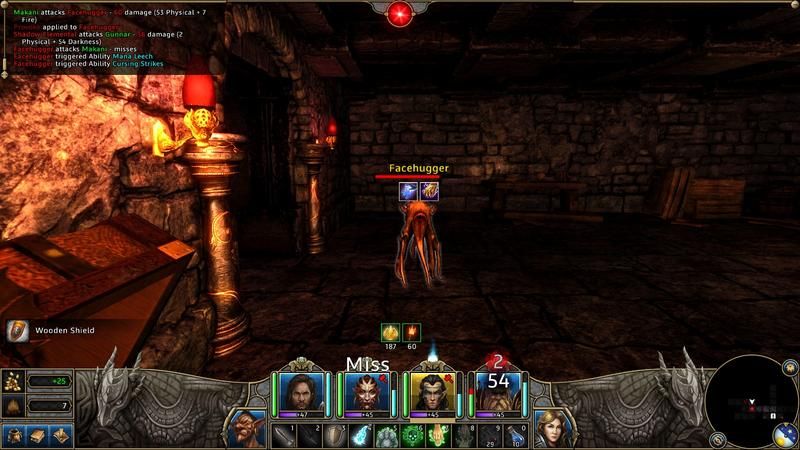
Oh, sweet! A facehugger! I can wear that as a helmet.
While a few drops are static (chiefly, relics/artifacts), most loot is randomly generated at the start of the game. The random loot uses an affix/suffix system that should be familiar from any other number of games. Generally, good items tend to offer a basic bonus (+3 fire damage, say) and a special bonus, like healing the character for a portion of the damage dealt. Needless to say, some bonuses are wildly better than others (would you like to have a 3% chance to deal 10 damage to the enemy group, or have an extra strike every time you attack?), which is both interesting and horrifying, depending on how much of a masochistic badass you happen to be. If your party happens to be using daggers, but no two-handed weapons, you'd better hope you don't roll up ten two-handed swords from the next dozen chests you open.
So, Unity...
MMXL is a pretty game. Sort of. This is a hard call to make. On the one hand, it leverages a lot of art from Heroes 6, which is all of top-notch quality, whatever you think of that game. At times, it feels like it's punching way above its budget level (which has been implied to be pretty low). Remember, this is a game niche enough that it's not going to be released in brick & mortar retailers. And the art added by Ubisoft specifically for MMXL is all rather good, and more importantly, strikes its own noticeable style. The handpainted 2D portraits that reflect a character's health (paralyzed, stunned, poisoned, et cetera) and the solid, weighty UI all strive to go against the current grain of streamlined, anodyne presentation and do a great job of driving the high fantasy theme home.
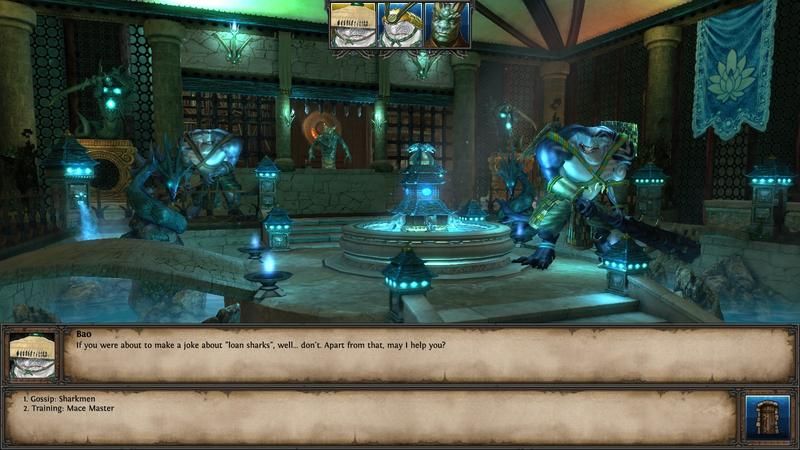
Some people said Ubisoft couldn't possibly replicate Caneghem's cheesy sense of humor. Air guitar playing loan sharks would like to disagree.
All of that, however, is let down by the engine. Unity clearly struggles with larger environments, and Agyn Peninsula is definitely a large environment. The entire open world outdoors map is one huge level. No "move to next area" loading tricks here. In addition, the assets that weren't made by Ubisoft (read: Unity Store) distract. They're most common in the towns and villages of MMXL, which creates a weird dichotomy. When adventuring in dungeon tilesets that are 100% Ubisoft assets, I'm completely sold on the fantasy. Enter a town, or wander in the wilderness, and I feel as if I'm playing a different game.
Disclaimers have to be thrown out there: MMXL is not complete. They are still optimizing. But this is still starting to look something like a trend. Our Blackguards preview touched on a similar subject, where Daedalic's usually fantastic art was letdown by the same middleware engine. Most of all, this makes me worry for the sheer number of Kickstarter wunderkind that are employing Unity. Is it even possible to develop a "modern"-looking game without shelling out for one of the big, professional 3D engines?
Off The Beaten Path
The open world is indisputably the star of MMXL. Once past the "tutorial area" that is Act I, the world awaits. There are no artificial restraints placed on your party. You can go wherever you want, whenever you want. Sure, you might die horribly, but that's a definite part of the charm. Some areas--such as islands or mountain ranges--require the Blessings to reach, but the Blessings themselves are merely a matter of exploration to obtain.
Trundling my party around the open world like a pack of ravenous hobos in search of crystal meth was by far the most fun I had with the exclusive preview. Beyond each twist in the road there's a new type of enemy, a crypt with a riddle to investigate, and a treasure chest hidden behind a stand of trees. This is MMXL at its best, and why you should absolutely keep an eye on it if you are a fan of the open-world blobber gameplay that Might & Magic and Wizardry pioneered.
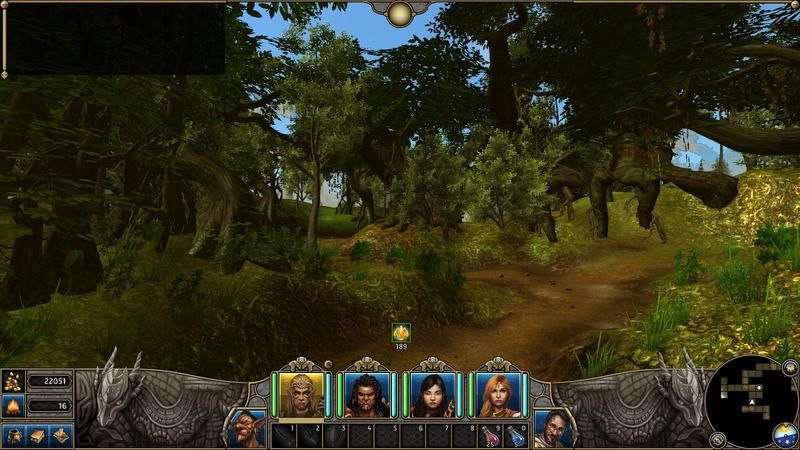
Woods as peaceful as these could be home to tranquil elves... OR a meth lab. Either one, really.
It's hard to put into words what's so addictive about this very basic sort of appeal, especially since wandering Skyrim's frozen wastes isn't half as interesting. On paper, they should be virtually identical. Maybe it's something to do with how very quantized a grid-based game is. Every other tile of the world is there for a reason, has something to do. MMXL doesn't have huge tracts of wilderness filled with nothing simply because it would be realistic. In terms of 3D real estate, MMXL is much smaller than the AAA giants of the industry, but it feels big.
The More Things Change, The More They Stay The Same
Oh, you want a final verdict? Alright, here's one: MMXL is actually a Might & Magic game. Limbic and Ubisoft made no presumptions here. They asked the fans what they wanted, and then they used the hallowed titles of the series as a blueprint. After a decade of wandering in the wilderness of sordid action games masquerading as roleplaying games, of suffering through people citing Oblivion as "one of the old-school greats", Might & Magic is back as something other than a strategy game. And it's genuine. Whatever its flaws, no matter how many bugs get stomped between now and release, MMXL will sink or swim based on the answer to one terrible question: do enough people still want to play this genre?
I fear the answer to that question, even as I hope it's a resounding 'YES!'.
PS. This lawnmower simulation is coming out on 'January 23rd'. Or so the Faceless would have us believe.
Limbic Entertainment's Might & Magic X: Legacy releases on Steam on January 23rd. Thanks to Limbic and Ubisoft, we got exclusive (tm) press access to Act II of the game. How good is this new act, and how does the game fare as a whole in its current state?
In this preview, Zeriel attempts to find out just that. To spice things up a bit, he's also accompanied by Broseph who adds a few scattered remarks here and there.

Hands-On-Collar Preview
It seems like only yesterday that we penned a
Ubisoft was kind enough to send us an exclusive preview build with a large portion of Act II available, huge swathes of the open world, along with 2 more classes to try out. And for the furry enthusiasts, we've even got a bare-chested minotaur.

You're welcome, Jasede.
Might & Magic X: So This Is That Grimrock Clone, Right?
Over a decade ago, the executives of 3DO were in a closed doors meeting discussing the future of a wildly popular RPG and Strategy franchise. "So, we've got this great brand. It has successful titles in two genres, and dedicated fans. How can we take this to the next level? Any ideas? Allen?"
"I know," said Allen, who unbeknownst to his fellow executives was the devil incarnate. "Why don't we push out a title in a year of development time, and switch to a completely unproven new engine? I hear Lithtech's all the rage with the kids!"
A year later, Might and Magic 9 came out, failed miserably, and a storied franchise died a horrible death. Through the incestuous horror that is copyright law, it somehow ended up in the claws of Ubisoft who... decided to revive it as a turn-based blobber? When MMXL was first announced, many at the Codex could not reconcile these two opposing concepts: Ubisoft of Assassin's Creed and Far Cry was reviving Might & Magic as a turn-based RPG? A turn-based RPG with grid movement?

Julien Pirou, Creative Designer on MMXL, moments before casting a hex of mind control.
Eventually the dark secret of MMXL's genesis leaked out: a clever warlock by the name of Julien Pirou had infiltrated the highest ranks of Ubisoft and used his witchcraft to subvert its executives to his will. Either that, or Ubisoft decided a niche title was a smart investment in a swamped AAA market where fighting for market share was increasingly futile. I ask you, which scenario is more plausible?
Partnered with Limbic, Ubisoft looked back to the earlier titles in the franchise for inspiration, while inviting a small group of VIP fans to discuss the development of the new product. Specifically, Might and Magic V: Darkside of Xeen, the last game in the series to feature fully turn-based combat and movement set in a grid.
If you're an old grognard who grew up playing games like Wizardry and the earliest Might and Magic titles, you don't need to know anything more: Might & Magic X is a beautiful dinosaur that just stepped out of a time machine. It marries old-fashioned mechanics that should never have been abandoned with a modern graphical approach. There is nothing else on the market quite like it, and for the fans of this forgotten genre it's an unavoidable day one purchase.

Be still, my heart! It's turn-based combat. In my 2013?
Welcome to Ashan
From a story perspective, MMXL has no connection to the previous Might & Magic games. It takes place on Ashan, a new high-fantasy setting used by the Heroes series that is Ubisoft's take on the franchise. It's the sort of place where Dragons are Gods instead of living loot factories, demons and angels are only living embodiments of evil and good rather than aliens jetting around in spaceships, and so on and so forth. Julien Pirou being the conniving warlock that he is, however, there are little references dotted throughout the game to the previous universes of Might and Magic. They vary from the sublime (subtle references that only leap out if you've played through the series) to the ridiculous (books of poetic verse written by 'Lord Caneghem' that detail the exploits of earlier games).

Real subtle, guys.
I'm of two minds on these easter eggs: on the one hand, it would be nice if fan input and Pirou's vile warlock incantations could one day convince Ubisoft to make a Might & Magic sequel with sci-fi elements. If, on the other hand, that's never going to happen, I wish they'd stop rubbing our face in that impossibility, and have more faith in their high fantasy setting. Within the scope of MMXL, Ashan is at times charming, and certainly always more believable than it ever was in Heroes 6. I'd like to think the fans of Might & Magic can come to enjoy Ashan without the sly references. The real reason we're playing MMXL, after all, is that it lives up to the gameplay legacy of Might & Magic, not because we're pining away for the Temple of Baa.
Broseph: I am pining away for that Temple of Meow dungeon I've heard about, though. I have a thing for cats.
The Life of the Party
Party creation is bog standard for the genre... two decades ago, in any case. You have the option of using a pregenerated party with a balanced class makeup, generating a completely random party (what genius came up with this idea?), or manual creation. Manual creation feels like the whole point of the game, but it's nice that Limbic gave some other options for those who bought, downloaded, and played MMXL on the mistaken assumption they were actually clicking the Skyrim icon on their desktop.
MMXL offers the option of two separate difficulty levels: Adventurer, and Warrior. It's hard to say which represents the "baseline" experience. As a longtime fan of the series, I found that I was only getting the challenge I wanted on Warrior, but Adventurer is no push-over for someone completely new to the genre. The changes between the difficulties are exclusively number-oriented: costs for everything from training skill tiers to buying equipment to fetching camping supplies are drastically increased on Warrior, and monster health and damage is also bumped up. There are no rewards or incentives, so it's purely a lifestyle choice.
Broseph: So far, MMXL is shaping up to be a more difficult game than previous entries in the series. Even on Adventurer, I found myself running into some tough situations that had me really thinking about what action to take next. Might & Magic games have never been terribly difficult, so the higher difficulty of MMXL came as a pleasant surprise to me. If you are the kind of person who likes to play games for their challenge, definitely go with Warrior mode. Otherwise, Adventurer offers a decent challenge as well, easily surpassing that of some of the latter games in the series.

Go right ahead. Just know that I'm judging you. From on high.
Character creation starts with choosing a race, which in turn determines the classes available to you. Every race has 3 classes, one each of the three archetypes: fighter, rogue, caster. Depending on the race, the flavor of these classes differs drastically. The elven rogue class, the Ranger, can max out the Dagger skill completely, becoming a fragile but deadly damage-dealing machine. Meanwhile, the Orc rogue archetype is the Marauder, a trap-laying barbarian who specializes in spears and avoids getting hit in the first place.
Classes in MMXL are basically just packages of skills: some classes can't pick certain skills, or are the only class able to raise that skill to the highest tier of mastery. Every class also has a promotion quest that transforms them into a paragon of their class with a new, added ability. As an example, the Freemage promotion gives the ability to stop time in an area around the party. Veterans of the series will find the cockles of their heart warmed by the inclusion of familiar skills, but a few are alarming in their absence. Alchemy, Diplomacy, Repair Item, Merchant... you're probably noticing a theme. All the trimmed skills are non-combat in nature. Thankfully, they're not simply gone. Many hirelings found in the world approximate the effects of the missing skills, like a follower who will improve your dealings with shops drastically, or one who repairs items for you at any time.
Broseph: While I do miss having these skills in the game, I think cutting them was probably a good choice. The absence of these skills is an effective way of communicating that this is going to be a combat-focused game.
Zeriel: I'm not so enlightened, myself. I want them back. The choice strikes me as triage: they knew they were making a game on a shoestring budget, so they cut as much fat and muscle as they could before hitting the bone.
Zeriel: I'm not so enlightened, myself. I want them back. The choice strikes me as triage: they knew they were making a game on a shoestring budget, so they cut as much fat and muscle as they could before hitting the bone.

Only one Pao Deathseeker. Must be a new player.
Meanwhile, the terrain traversal skills of Xeen are encapsulated in the concept of Blessings: favors from the Dragon Gods (they're for praying to, not stabbing in the gut) that eventually allow your party to walk on water, climb mountains, sneak between forest hedges, and so forth.
Ultimately though, MMXL is a game about combat, for people who love combat. All its skills and systems tend to revolve around combat, and even character creation ends with a button that says 'Into Battle'. In this way, it's little different from its predecessors, which were always about exploring strange places, butchering whoever lived there, and then taking their stuff.
While We're Here...
MMXL begins with your party unceremoniously shoved onto the dock of a small village, a sunny place named Sorpigal. A very brief narration establishes the story thus far: you are raiders, mercenaries in everything but name. Owen, your mentor, recently passed away, and his dying wish was that you take his ashes to the chapel in Karthal, the regional capitol of the Agyn Peninsula. Naturally you can't just head there directly, though! A series of coincidences and obstacles rise up on the way, and present the meat of the game. In a game about story, such a transparent ruse would be irritating, but with MMXL I just found myself smiling and going along with the developer's excuses meant to get me into the fray, slaying spiders and nagas and shadow dragons because... uh, you know, it's somehow terribly important to my quest. There's a well full of spiders? Sure, why not.

And so began the epic tale of how a group of homeless vagrants lawnmowered our entire world in search of things to sell.
While the setting is high fantasy, the plot of the game is very low-fantasy: you are in the Agyn Peninsula to fulfill a debt to a dead friend. As you get closer to Karthal, you discover the city is a hive of political intrigues tied to secession from the Empire. While there are villains and heroes, MMXL goes with a much more down to earth and pragmatic style than Heroes 6. Personally, I enjoyed it. If you thrive on being the Chosen One fated by Destiny to save the world, you might be a lot less satisfied.
Such Combat, Much Strategy
We've talked about combat in an oblique way before, but I wanted to dive into it in more detail especially because a lot of previews have glossed over this. What makes it good? What makes it bad?
Combat is turn-based. Your party goes through a round of actions, and then the enemy acts. You can only move during combat before any of your characters have acted, and if you choose to do so, your characters won't attack or cast spells that turn. In addition, once you're in melee range with an enemy, you can't back up. While at first blush these restrictions seem like emphatic negatives, in fact they are responsible for much of what is great about MMXL's combat.
Because you can't simply always backpedal and pepper your enemies with volleys of arrows and spells (a dominant tactic in M&M 6-8), terrain and obstacles become a serious consideration in combat. Luring enemy archers around a corner is much safer than trying to charge at them through a hail of covering fire. Some spells help with manipulating these basic elements: Gust of Wind, an air spell, will knock a target enemy back one square, allowing an all-ranged party to toy with melee combatants at their leisure.

'Much Strategy' hereby defined as 'keep burning it until it's dead'.
Compared to earlier Might and Magic games, melee characters are much more interesting. Instead of autoattacking ad nauseam, they can specialize in the Warfare skill, which provides an entire line of melee "spells", with strikes that taunt an enemy into attacking that character, always hit and ignore blocks, or silence enemy spellcasters. As a result, beefy frontliner characters have a solid niche in MMXL.
Enemy design adds to the mix. In many areas, each new enemy you run into uses a completely different mechanic to challenge your typical approach to combat. Just when you feel like your Ranger with 4 attacks a round is turning into an overpowered death machine, a monster arrives that not only blocks the first few strikes in a round, but gets extra attacks on his round based on how many times he blocked or was missed on your round. An all melee party would be uniformly powerful... until it starts running into the monsters that stun and incapacitate when they attack, suddenly making that spellcaster with a stun immunity spell look quite useful.
Finally, the elephant in the room: monster animations suck. No, I don't mean aesthetically. The monster art is uniformly good, much of it ported over from the visually impressive Heroes 6. The animations are smooth. The problem is that the animations have no options attached to them. You cannot speed them up. You cannot toggle them to skip once you've seen them all a million times. This is further exacerbated by the way your own combat moves work: they all fire instantly, and the animations and special effects do not have to finish before your next character can act. The end result is a quick, ultra satisfying turn on your end, followed by watching the enemy plod through animations you've already seen before. If Limbic addresses this fundamental issue, they'll have one of the best turn-based combat games in recent memory. If they don't... well, it'll still be good, but with a sidedish of irritating, and probably not an enduring classic.
Broseph: The improvements to the combat system in this game over previous titles are very welcome. While still pretty simplistic compared to say, Wizardry, Limbic has managed to breathe some life into battles which were previously either boring or nothing special. My biggest gripe with the combat is not even the animations, although they are a bit slow. It just takes way too damn long for enemies to move into different tiles. In a game this heavy on combat, making it quick and responsive should be a top priority. The underpinnings of some really fun gameplay are here, but everything needs to be sped up.
Zeriel: I think what you're describing is the fault of the animations. If you look closely, you can see that when monsters move from tile to tile, the red dot showing their location changes instantly. But the game then waits for the animation to play out fully before anything else can happen. In essence, with players the game allows new characters and actions to be taken while graphical effects of previous actions are still taking place. With monsters, it always waits.
Zeriel: I think what you're describing is the fault of the animations. If you look closely, you can see that when monsters move from tile to tile, the red dot showing their location changes instantly. But the game then waits for the animation to play out fully before anything else can happen. In essence, with players the game allows new characters and actions to be taken while graphical effects of previous actions are still taking place. With monsters, it always waits.
Right, But What's Changed?
Act II brings with it the majority of the open world, and a handful of new dungeons, along with the town of Seahaven. 2 new classes are on offer over the current Early Access. The first is the Rune Priest, a dwarven spellcaster who can master Light and Fire, providing strong healing and damage dealing capabilities. The second class is the Marauder, the Orc take on the rogue archetype who focuses on Spears and Dodge, with a class promotion ability to lay traps later on.
Broseph: I quite enjoyed the Rune Priest class in particular. It's a classic glass cannon archetype and does a very good job of both dishing out damage and shielding your allies from harm. I found having a Rune Priest in my party to be a big help with some of the nastier enemies in Act II.
Zeriel: The class balance is a little alarming. Even at this early stage there are clearly classes that are simply not as good at others at their chosen role. Why use a Marauder over a Ranger? The Ranger is better at dealing damage. The Marauder can block attacks very well, but if that's the role you're after, there are defensive melee classes that are better at it. In a way, though, this is very old school. In Baldur's Gate 2, the correct choice of class was always sorceror, no matter what. In earlier Might & Magic games, there was almost always a class that was the best at any given job, and then the mediocre ones.
Zeriel: The class balance is a little alarming. Even at this early stage there are clearly classes that are simply not as good at others at their chosen role. Why use a Marauder over a Ranger? The Ranger is better at dealing damage. The Marauder can block attacks very well, but if that's the role you're after, there are defensive melee classes that are better at it. In a way, though, this is very old school. In Baldur's Gate 2, the correct choice of class was always sorceror, no matter what. In earlier Might & Magic games, there was almost always a class that was the best at any given job, and then the mediocre ones.

New Dojo, new rules.
Seahaven is the standout addition in the exclusive preview. While not the largest town in the game (Karthal presumedly takes on that role), it is considerably larger than Sorpigal, offering a variety of Expert and Master trainers, and several new quests to boot. Aesthetically it's also more impressive than Sorpigal, featuring a Naga and Dwarven quarter in addition to the usual human element.
The new dungeons include Sudgerd, a lost dwarven city hidden in the mountains that fell to some shadowy evil in centuries past. Tales of madness and ruin offer a nice preview of what's to come, and the promotion quest for the Rune Priest involves relighting the fires of Arkath (that's one of those Dragon Gods) in the center of Sudgerd. To do so, you'll have to fight... well... not to put too fine a point on this, but I think the Codex is amply equipped to deal with plumbing the "depths" of this "dungeon".

Ubisoft included this lovely little picture in the press packet. How well they know us.
The earliest builds of the early access (including the one our own Zed previewed) lacked things like stores restocking potions and changing their inventory every few days. That's been changed, along with a lot of general polish in terms of lighting and area design. In Act I especially, entire regions have had monsters moved around or replaced with something else--instead of fighting brigands and militiamen right outside the gates of Sorpigal, the player now encounters wildlife like wolves.
Broseph: Speaking of wolves, they are downright nasty here. It's not very often that you see an RPG where wolves pack more of a punch than griffins and chimeras.
The change to stores doesn't really affect the difficulty. While you can always wait for more potions to restock in stores, it hardly trivializes the game. Especially on Warrior difficulty, the limiting factor at any time is gold, which can only be obtained by pushing forward into new areas, since monsters never respawn. You'll find yourself wanting to spend it on skill training and items much more often than potions. This creates an interesting dynamic in the early to midgame: the player can never sit back on his ass and farm until he feels overpowered and ready to face any challenge. The game always nudges you ahead into something that's just hard enough to keep your attention.
We were told that all of the content in the exclusive preview amounted to about 30% of the final game. This is interesting considering there will only be four acts--suggesting that the Act II we played was not the entirety of the Act II that will be in the retail product.
Deeply Delving Dungeons
What's a Might and Magic game without dungeons? At first blush, I was a little disappointed in this area. The very first dungeon in MMXL is a short, linear affair that calls to mind all the worrisome trends of the last decade. Things change quickly, however, and by the time Act I ends you're breaking into secret passages in search of treasure chests, flipping switches and backtracking to find unexplored rooms.
Fundamentally there's nothing mindblowing about what MMXL uses to break up the pace of monster genocide: levers to open passages that lead to keys to locked doors in another part of the dungeon, but the abundance of riddles and puzzles is definitely much needed in a game that relies so heavily on combat.

You may recall this dashing young fellow from the concept art.
MMXL reaches the bar set by the previous games in this department, but doesn't really venture any further. The average dungeon in MMXL is probably a little more complicated than the most standard ones in For Blood & Honor, say, but overall the design is just on par. What really impressed me with MMXL's dungeons was the pacing. They're just long enough to threaten to exhaust your supplies, maybe even merit a return to town and a second visit, but just about every time I was reaching that familiar mental stage of 'Shouldn't I be reaching the end about now?', a boss would pop up, and I'd be finishing off the dungeoncrawl. Such consistency isn't easy to nail, and it's nice to see competency from what is basically an untested developer when it comes to this genre.
Broseph: From MM7 forward, the series pretty much abandoned the gigantic endurance test dungeons of the older titles, and MMXL stays true to the trend. There's nothing like the Temple of Baa or the Red Dwarf Mines here, so don't expect any rooms filled with hundreds of skeletons or endless, winding corridor shooter sections where you literally pop moles. I can't deny that I miss the former, but in general the dungeon design here gets the job done and does it pretty well.
You'll See, I'll Be King Of The World, One Day...
Character progression in MMXL feels dramatically quicker than in Might and Magic 6-8. Perhaps this is in part due to the shrinking of encounter size (the 3D, quasi-real-time era of Might & Magic had a propensity of throwing absurd numbers of enemies at you), but it's still worth mentioning. My hunch is that this is a game of horizontal rather than vertical depth: a large world to explore, but not one in which it will take very long to turn your party into a powerhouse. Within a few hours, your
Broseph: While I think a slower progression makes you feel more accomplished when you look back on how far your party has come later on, hastening the leveling speed and cutting the trash combat will do wonders for replay value (...though my rear end still feels sore about the axing of the training centers).
Weapons also play a much larger role in 'physical' characters' performance. It's not uncommon to get the next 'tier' of weapon and find your damage doubling. It was always the case that melee characters in Might & Magic derived much more benefit from weapons than spellcasters, but this trend is only accelerated in MMXL. Where a melee character's damage might double from a weapon upgrade, a spellcaster will get a staff that gives +3 to their chosen spellcasting skill, offering a benefit of maybe 15% increased damage. You may be noticing a small difference between "+100%" and "+15%". Spellcasters have their own immense benefits to recommend them to any party, like heaping spoonfuls of area of effect damage, and all sorts of utility that can't be had any other way. Does that merit allowing melee to scale with gear in such a superior way? At this stage, it's hard to say.

Oh, sweet! A facehugger! I can wear that as a helmet.
While a few drops are static (chiefly, relics/artifacts), most loot is randomly generated at the start of the game. The random loot uses an affix/suffix system that should be familiar from any other number of games. Generally, good items tend to offer a basic bonus (+3 fire damage, say) and a special bonus, like healing the character for a portion of the damage dealt. Needless to say, some bonuses are wildly better than others (would you like to have a 3% chance to deal 10 damage to the enemy group, or have an extra strike every time you attack?), which is both interesting and horrifying, depending on how much of a masochistic badass you happen to be. If your party happens to be using daggers, but no two-handed weapons, you'd better hope you don't roll up ten two-handed swords from the next dozen chests you open.
So, Unity...
MMXL is a pretty game. Sort of. This is a hard call to make. On the one hand, it leverages a lot of art from Heroes 6, which is all of top-notch quality, whatever you think of that game. At times, it feels like it's punching way above its budget level (which has been implied to be pretty low). Remember, this is a game niche enough that it's not going to be released in brick & mortar retailers. And the art added by Ubisoft specifically for MMXL is all rather good, and more importantly, strikes its own noticeable style. The handpainted 2D portraits that reflect a character's health (paralyzed, stunned, poisoned, et cetera) and the solid, weighty UI all strive to go against the current grain of streamlined, anodyne presentation and do a great job of driving the high fantasy theme home.

Some people said Ubisoft couldn't possibly replicate Caneghem's cheesy sense of humor. Air guitar playing loan sharks would like to disagree.
All of that, however, is let down by the engine. Unity clearly struggles with larger environments, and Agyn Peninsula is definitely a large environment. The entire open world outdoors map is one huge level. No "move to next area" loading tricks here. In addition, the assets that weren't made by Ubisoft (read: Unity Store) distract. They're most common in the towns and villages of MMXL, which creates a weird dichotomy. When adventuring in dungeon tilesets that are 100% Ubisoft assets, I'm completely sold on the fantasy. Enter a town, or wander in the wilderness, and I feel as if I'm playing a different game.
Disclaimers have to be thrown out there: MMXL is not complete. They are still optimizing. But this is still starting to look something like a trend. Our Blackguards preview touched on a similar subject, where Daedalic's usually fantastic art was letdown by the same middleware engine. Most of all, this makes me worry for the sheer number of Kickstarter wunderkind that are employing Unity. Is it even possible to develop a "modern"-looking game without shelling out for one of the big, professional 3D engines?
Broseph: MMXL is quite pretty, and even better looking than a lot of AAA games in recent years. I just hope that they're able to optimize it to the point where the game can manage a consistent 60 frames per second.
Zeriel: I don't want to belabor the point since this is still definitely an under-construction build, but this is one weak point that could bring the whole game tumbling down. If it releases in its current state of optimization, I'm not sure what to say. A lot of people would be disappointed. I have a fairly good rig for this sort of game and performance issues were consistently the thing that made MMXL anything but a joy to play. Battlefield 4 should not run more smoothly than MMXL.
Zeriel: I don't want to belabor the point since this is still definitely an under-construction build, but this is one weak point that could bring the whole game tumbling down. If it releases in its current state of optimization, I'm not sure what to say. A lot of people would be disappointed. I have a fairly good rig for this sort of game and performance issues were consistently the thing that made MMXL anything but a joy to play. Battlefield 4 should not run more smoothly than MMXL.
Off The Beaten Path
The open world is indisputably the star of MMXL. Once past the "tutorial area" that is Act I, the world awaits. There are no artificial restraints placed on your party. You can go wherever you want, whenever you want. Sure, you might die horribly, but that's a definite part of the charm. Some areas--such as islands or mountain ranges--require the Blessings to reach, but the Blessings themselves are merely a matter of exploration to obtain.
Trundling my party around the open world like a pack of ravenous hobos in search of crystal meth was by far the most fun I had with the exclusive preview. Beyond each twist in the road there's a new type of enemy, a crypt with a riddle to investigate, and a treasure chest hidden behind a stand of trees. This is MMXL at its best, and why you should absolutely keep an eye on it if you are a fan of the open-world blobber gameplay that Might & Magic and Wizardry pioneered.

Woods as peaceful as these could be home to tranquil elves... OR a meth lab. Either one, really.
It's hard to put into words what's so addictive about this very basic sort of appeal, especially since wandering Skyrim's frozen wastes isn't half as interesting. On paper, they should be virtually identical. Maybe it's something to do with how very quantized a grid-based game is. Every other tile of the world is there for a reason, has something to do. MMXL doesn't have huge tracts of wilderness filled with nothing simply because it would be realistic. In terms of 3D real estate, MMXL is much smaller than the AAA giants of the industry, but it feels big.
Broseph: The wilderness areas in this game are downright awesome. Incredibly fun to explore, with lots of well-hidden secrets and goodies. The map design positively reminds me of MM3. Exploring the overworld here doesn't feel like a chore at all, unlike in some other games of this type where the dungeons are the real meat and potatoes of the experience.
Zeriel: On the off chance that Julien is reading this: consider rethinking relics. As is, they seem exclusively available through crypts that are pure riddles, no combat involved. While the riddles are nice, it's merely a matter of trial and error to grab these relics, at a very early level. My understanding is that relics are supposed to grow into very powerful items. If they aren't, the current design is fine. If they will become very good, I think they should be a little harder to obtain.
Zeriel: On the off chance that Julien is reading this: consider rethinking relics. As is, they seem exclusively available through crypts that are pure riddles, no combat involved. While the riddles are nice, it's merely a matter of trial and error to grab these relics, at a very early level. My understanding is that relics are supposed to grow into very powerful items. If they aren't, the current design is fine. If they will become very good, I think they should be a little harder to obtain.
The More Things Change, The More They Stay The Same
Oh, you want a final verdict? Alright, here's one: MMXL is actually a Might & Magic game. Limbic and Ubisoft made no presumptions here. They asked the fans what they wanted, and then they used the hallowed titles of the series as a blueprint. After a decade of wandering in the wilderness of sordid action games masquerading as roleplaying games, of suffering through people citing Oblivion as "one of the old-school greats", Might & Magic is back as something other than a strategy game. And it's genuine. Whatever its flaws, no matter how many bugs get stomped between now and release, MMXL will sink or swim based on the answer to one terrible question: do enough people still want to play this genre?
I fear the answer to that question, even as I hope it's a resounding 'YES!'.
Broseph: I can already smell the burning of torches and hear the sharpening of pitchforks over our overly positive assessment of this game. In all seriousness, MMXL has everything it needs to be the next great title in the series. A few design decisions grind my gears, there are a lot of bugs yet to be fixed, and the game suffers from a slowness which plagues a lot of turn-based RPGs. In spite of these flaws, MMXL could end up being the best game in the series yet(!). I can only hope that the late game content ends up being as entertaining and well-designed as what's been presented so far in Acts I and II.
Zeriel: Whoa there, cowboy! I don't think MMXL quite manages to rival Xeen, several decades of technological advantages notwithstanding. We shouldn't expect it to, anyway. This is an entirely different team. That it'll come close to matching Xeen would be enough of a miracle for me.
Zeriel: Whoa there, cowboy! I don't think MMXL quite manages to rival Xeen, several decades of technological advantages notwithstanding. We shouldn't expect it to, anyway. This is an entirely different team. That it'll come close to matching Xeen would be enough of a miracle for me.
PS. This lawnmower simulation is coming out on 'January 23rd'. Or so the Faceless would have us believe.
There are 94 comments on RPG Codex Preview: Might & Magic X: Legacy, Now with Act II














